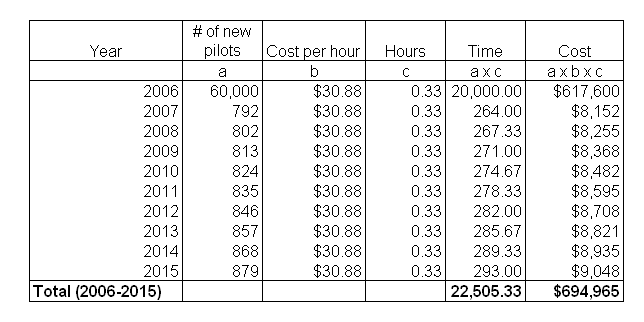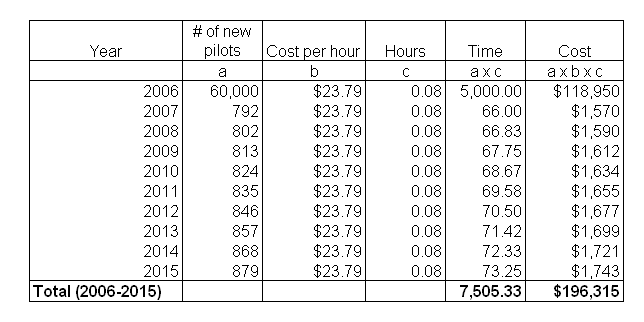Special Awareness Training 8-1
Special Awareness Training 8-1.doc
Special Awareness Training for the Washington DC Metropolitan Area
OMB: 2120-0734
INFORMATION COLLECTION CLEARANCE
THE SUPPORTING STATEMENT
Special Awareness Training for the Washington, DC Metropolitan Area Direct Final Rule
Introduction: This information collection request is for the “Special Awareness Training for the Washington, DC Metropolitan Area” proposed rule. This information collection is needed to establish a National database registry for those pilots who are required to receive training and testing in order to fly within 100 nm of the Washington, DC VOR.
Explain the circumstances that make the collection of information necessary. Identify any legal or administrative requirements that necessitate the collection. Attach a copy of the appropriate section of each statue and regulation mandating or authorizing the collection of information. (Annotate the CFR parts/sections affected).
This collection of information would be required of persons who must receive training and testing under 14 CFR § 91.161 in order to fly within 100 nautical miles (nm) of the Washington, DC omni-directional range/distance measuring equipment (DCA VOR/DME). For a person to enroll in the FAA’s “Washington, DC Area Training Program”, the rule would require persons to electronically furnish their names, residence addresses, and pilot certificate numbers.
This information collection supports Department of Transportation’s strategic goal on security.
Indicate how, by whom, and for what purpose the information is to be used. Except for a new collection, indicate the actual use the agency has made of the information received from the current collection.
This collection of information would be solicited by the FAA in order to establish a National database registry for those persons who are required to receive training and be tested for flying in the airspace that is within 100 nautical miles (nm) of the DCA VOR/DME. This National database registry would provide the FAA with information on how many persons and the names of those who have completed this training. This information would be needed so that the FAA can answer to the U.S. Congress on the success of this program.
Describe whether, and to what extent, the collection of information involves the use of automated, electronic, mechanical, or other technological collection techniques or other forms of information technology, e.g., permitting electronic submission of responses, and the basis for the decision for adopting this means of collection. Also describe any consideration of using information technology to reduce burden. [Effective 03/22/01, your response must SPECIFICALLY reference the Government Paperwork Elimination Act (GPEA), which addresses electronic filing and recordkeeping, and what you are doing to adhere to it. You must explain how you will provide a fully electronic reporting option by October 2003, or an explanation of why this is not practicable.]
This information would be collected electronically when the person logs onto the website to take the training and test. The only information that would be collected would be the person’s name, address, and pilot certificate number and that information would be collected when the person logs on to the FAA website to initiate the training and test.
Describe efforts to identify duplication. Show specifically why any similar information already available cannot be used or modified for use for the purpose(s) described in Item 2 above.
There is no duplicate requirement that would provide the FAA this information. This requirement for information collection would be a new requirement for pilots who are required to receive training and testing in order to fly within 100 nautical miles (nm) of the DCA VOR/DME.
If the collection of information has a significant impact on a substantial number of small businesses or other small entities (Item 5 of the Paperwork Reduction Act submission form), describe the methods used to minimize burden.
This information collection would be required of individuals and not small business and small entities. The information would be only required of the individual who intends to operate under visual flight rules (VFR) within 100 nautical miles (nm) of the DCA VOR/DME.
Describe the consequence to Federal program or policy activities if the collection is not conducted or is conducted less frequently, as well as any technical or legal obstacles to reducing burden.
The FAA anticipates that a number of U.S. Congressional subcommittees will be asking FAA management officials to account for whom and how many are taking this required training. Without this information collection requirement, the FAA would not be able to provide information to these U.S. Congressional subcommittees on the number of persons who are receiving this required training. The reason for the person to submit his name, address, and pilot certificate is only for FAA purposes to ensure positive identification for issuance of the certificate of training completion.
Explain any special circumstances that require the collection to be conducted in a manner inconsistent with the general information collection guidelines in 5 CFR 1320.5(d)(2).
There are no special circumstances that require this collection to be conducted in a manner inconsistent with the general information collection guidelines of 5 CFR 1320.5(d)(2).
Describe efforts to consult persons outside the agency to obtain their views on the availability of data, frequency of collection, the clarity of instructions and recordkeeping, disclosure, or reporting format (if any), and on the data elements to be recorded, disclosed, or reported. If applicable, provide a copy and identify the date and page number of publication in the Federal Register of the agency's notice, required by 5 CFR 1320.8(d) soliciting comments on the information collection prior to submission to OMB. Summarize public comments received in response to that notice and describe actions taken by the agency in response to these comments. Specifically address comments received on cost and hour burden.
The “Special Awareness Training for the Washington, DC Metropolitan Area” proposed rule was published in the Federal Register on July 5, 2006, Vol. 71, No. 128, pgs. 38118-38125, so the public and interested parties could be afforded the opportunity to comment about the information collection requirements.
Explain any decision to provide any payment or gift to respondents, other than remuneration of contractors or grantees.
This question is not applicable to this information collection requirement.
Describe any assurance of confidentiality provided to respondents and the basis for the assurance in statute, regulation, or agency policy.
The information would be safeguarded on an FAA National database registry. The information would only be provided to other FAA offices for investigation purposes for airspace infractions of the airspace within 100 nautical miles (nm) of the DCA VOR/DME. U.S. Congressional subcommittees would most likely only need the information as a total number figure.
This collection is covered under the Privacy Act System of Records (SOR) “DOT/FAA 847—Aviation Records on Individuals.” There is no Privacy Impact Analysis (PIA) associated with this collection as the system of records was “grandfathered” and has not changed.
Provide additional justification for any questions of sensitive nature, such as sexual behavior and attitudes, religious beliefs, and other matters that are commonly considered private.
This information collection would not require respondents to answer questions of a sensitive nature, or on matters of a sexual behavior, sexual attitudes, religious beliefs, and other sensitive, private matters. As stated previously in some of the preceding answers to the questions, the only information that would be collected would be the person’s name, address, and pilot certificate number, and that information would be collected when the person logs on to the FAA website to initiate the training and test.
Provide estimates of hour burden of the collection of information.
Cost of Exam: Each person would need to take a test on the training.
To calculate this cost the following assumptions were used, paralleling those in the regulatory evaluation:
The FAA estimates that approximately 60,000 pilots that fly VFR within 100 nautical miles of the DCA VOR/DME would be affected by the rule.
Based on the FAA’s Aerospace Forecasts, for fiscal years 2005-2014, the FAA estimated that the affected population of pilots would grow at approximately 1.32 percent per year.
We estimate that the cost of time for persons who must complete the training program is $30.881 an hour.
We assume that each person will spend 20 minutes taking the test.
First Year Cost
Cost = 60,000 persons x $30.88/hour x (1/3) hours = $617,600.
Time = 60,000 persons x (1/3) hours = 20,000.00 hours.
Subsequent Years Costs
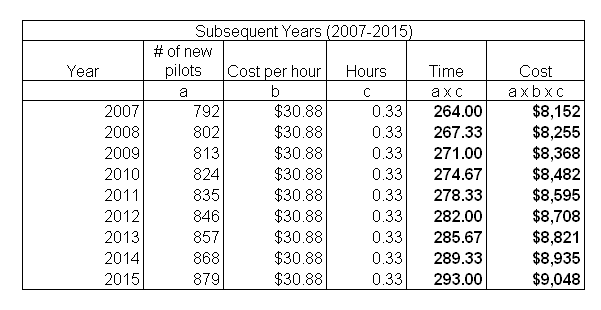
Total over 10 years
Average per year
Cost = $694,965/10 = $69,497.
Time = 22,505.33/10 = 2,250.53 hours.
Over the first three years, there will be 61,594 respondents (60,000 first year, 792 second year, and 802 third year), for a total of 20,531 hours (61,594 x 20 minutes).
Provide an estimate of the total annual cost burden to respondents or record keepers resulting from the collection of information.
There are no additional costs not already included in question 12.
Provide estimates of annualized cost to the Federal Government. Also, provide a description of the method used to estimate cost, and other expenses that would not have been incurred without this collection of information.
There are three sets of costs related to this section:
1. Cost of hosting and managing the course: The government would have to pay the contractor for hosting and managing the course.
To calculate this cost the following assumptions were used, paralleling those in the regulatory evaluation:
The FAA estimates that approximately 60,000 pilots that fly VFR within 100 nautical miles of the DCA VOR/DME will be affected by the rule.
Based on the FAA’s Aerospace Forecasts, for fiscal years 2005-2014, the FAA estimated that the affected population of pilots would grow at approximately 1.32 percent per year.
We estimate the wage for a programmer (FG-14) in Washington, D.C. who would host and manage the course at $61.28 an hour.
We assume that it would take him or her 2 minutes per person.
First Year Cost
Cost = 60,000 persons x $61.28/hour x (2/60) hours = $122,560.
Time = 60,000 persons x (2/60) hours = 2,000.00 hours.
Subsequent Years Costs
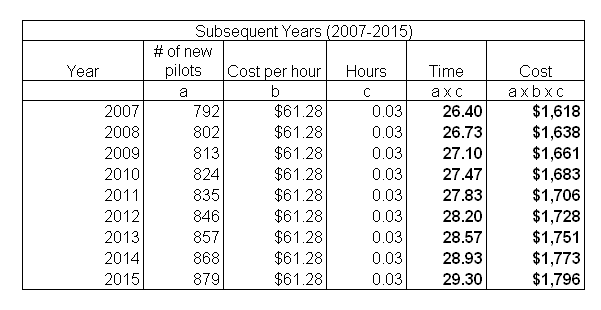
Total over 10 years
Average per year
Cost = $199,925/10 = $19,993.
Time = 4,505.33/10 = 450.53 hours.
2. Cost to develop a national registry: The FAA would have to develop a national registry for persons who have been trained.
To calculate this cost the following assumptions were used, paralleling those in the regulatory evaluation (Given that the locality pay rate in Oklahoma City is lower than in Washington, DC, the FG-15 and FG-14 pay rates used in this calculation are lower than those used above.):
We estimate the wage for a manager (FG-15) who would develop the national registry at $69.75 an hour.
We estimate the wage for a programmer (FG-14) who would also develop the national registry at $59.30 an hour.
We assume each would spend 160 hours each to develop the national registry.
First Year Cost
Cost = (160 hours x $69.75) + (160 hours x $59.30) = $20,648
Time = 160 hours + 160 hours = 320 hours
The FAA assumes no subsequent year costs.
3. Cost of entering data into the national registry: A clerical person enters data into the national registry to keep a record of who took the course.
To calculate this cost the following assumptions were used, paralleling those in the regulatory evaluation:
The FAA estimates that approximately 60,000 pilots that fly VFR within 100 nautical miles of the DCA VOR/DME will be affected by the rule.
Based on the FAA’s Aerospace Forecasts, for fiscal years 2005-2014, the FAA estimated that the affected population of pilots would grow at approximately 1.32 percent per year.
We estimate the wage for a clerical person at $23.79 an hour. (Given that the locality pay rate in Oklahoma City is lower than in Washington, DC, the FG-7 pay rate used in this calculation is lower than those used above.)
We assume that a clerical person would spend 5 minutes doing entering the data for each person into the national registry.
First Year Cost
Cost = 60,000 persons x $23.79/hour x (5/60) hours = $118,950.
Time = 60,000 persons x (5/60) hours = 5,000.00 hours.
Subsequent Years-per Costs
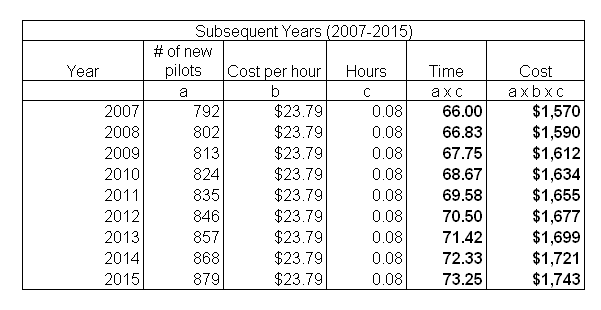
Total over 10 years
Average per year
Cost = ($196,315/10 = $19,632.
Time = 7505.33/10 = 750.53 hours.
Total ten-year cost = $199,925 + $20,648 + $196,315 = $292,335.
Total ten-year time = 4505.33 + 320 + 7,505.33 = 12,330.66 hours.
Average yearly cost = $41,689.
Average annual time = 1,233.07 hours.
Explain the reasons for any program changes or adjustments reported in Items 13 or 14 of the OMB Form 83-I.
This would be a new collection. Therefore, there is a program change.
For collections of information whose results will be published, outline plans for tabulation and publication. Address any complex analytical techniques that will be used. Provide the time schedule for the entire project, including beginning and ending dates of the collection of information, completion of report, publication dates, and other actions.
The information collected would not be published. The information would only be maintained on an FAA National database registry.
If seeking approval to not display the expiration date for OMB approval of the information collection, explain the reasons that display would be inappropriate.
The FAA is not seeking approval to not display the expiration date for OMB approval of the information collection.
Explain each exception to the certification statement identified in Item 19, “Certification for Paperwork Reduction Act Submissions,” of OMB Form 83-I.
There is no exception to the certification statement identified in Item 19 “Certification for Paperwork Reduction Act Submissions,” of OMB Form 83-I.
1 $26.30 (1.1045/0.9218). Economic Values for Evaluation of FAA Investment and Regulatory Programs, Report No. FAA-APO-98-8, June 1998 – Table 1-1.
| File Type | application/msword |
| File Title | Introduction: This information collection request is for the “Special Awareness Training for the Washington, DC Metropolitan |
| Author | ABA |
| Last Modified By | ABA |
| File Modified | 2006-08-01 |
| File Created | 2006-08-01 |
© 2026 OMB.report | Privacy Policy
